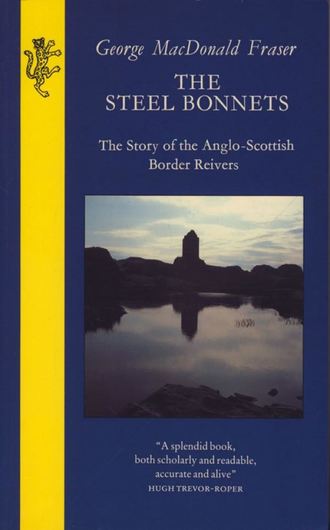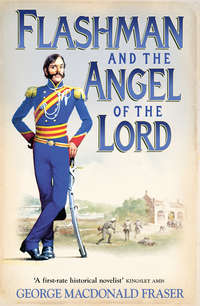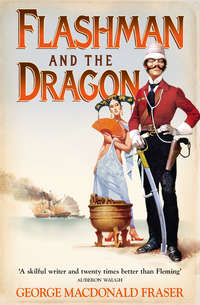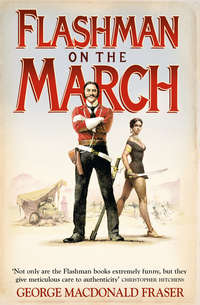
Полная версия
The Steel Bonnets
5. There were many Walter Scotts of Branxholm and Buccleuch, the principal ones being that Walter Scott who fought at Flodden and Ancrum, was briefly Middle March Warden, and was murdered by the Kerrs in 1552; and his grandson, the “Bold Buccleuch” (1565–1611), a noted reiver who was also Keeper of Liddesdale from 1594–1603, and who is famous for his rescue of Kinmont Willie Armstrong from Carlisle in 1596. When Buccleuch is mentioned in this text it means the grandson, unless otherwise stated.
6. Henry and Thomas Scrope (or Scroop) were respectively 9th and 10th Lords Scrope of Bolton. Henry (1534–1592) was English West March Warden from 1563 until his death; his son, Thomas (1567?–1600) held the office from 1592 to 1603. Henry was an able Warden, Thomas much less so (he was the unlucky victim of the Kinmont raid). To avoid confusion, they are referred to in the text as old Scrope and young Scrope where necessary.
7. He also noted that Scottish gentlemen wore little extra adornment by way of lace, and tended to follow French fashion as to cut. Married gentle-women wore “close upper bodices after the German fashion with large whalebone sleeves after the French; short cloaks like the Germans, French hoods and large falling bands about their necks. The unmarried of all sorts go bare-headed and wear short cloaks like the virgins of Germany. The lower sort of citizens’ wives and the women of the country wore cloaks made of a coarse stuff of two or three colours in checker work vulgarly called pladden”.
8. de Ayala, in 1498, thought Scotswomen had the handsomest headdresses in the world, but omitted to describe them.
9. Wheat had doubled in price, and meat and butter gone up by 30%.
VII
The riding surnames
It is significant that in the sixteenth-century Borderland the words “road” and “raid” were synonymous. So were “raiding” and “riding”—when the Armstrongs, for example, were described as “ever riding”, it meant simply that they never ceased from foraying. So when one speaks of the riding surnames, the phrase covers those families who were the principal reivers.
Any list of them must be selective, and what follows is not a comprehensive roll, but a brief and general guide to the main riding tribes, with some of the smaller surnames added because they are of particular interest. It should be remembered that the names are not chosen for national or political importance, but for their prominence in the limited sphere of frontier reiving; thus the Douglases and Percies, famous families who were active in the early days of Border warfare, are omitted, because they were hardly riding families, while the Burns and Storeys, comparatively unimportant in any national sense, are included because they were active forayers.
Similarly, the personalities mentioned have been chosen only for their Border interest—e.g. Richie of Brackenhill is not a shining light in the roll of the whole Graham family, which includes people like Montrose and Claverhouse, but he was a Borderer and they were not.
In listing twenty-one tribes I have simply given their names, with some of their alternative spellings where appropriate; then their main areas of occupation (it will be noted that some of them lived on both sides of the frontier) and principal Border branches; a short comment; a selection of some noteworthy individuals, and a final line indicating the status and numbers of the family in the Border country today.
ARMSTRONG
(Armstrang)
Principally Scottish, but probably of Cumbrian origin, Liddesdale, DL1, Eskdale, Annandale, EWM, SEM. Chief branches, Mangerton, Whithaugh, Calfhills, etc.
The name means literally what it says (cf. Fortinbras), and the Armstrongs were the most feared and dangerous riding clan on the whole frontier. As Satchells put it:
On the Border was the Armstrongs, able men,
Somewhat unruly, and very ill to tame.
In Johnnie Armstrong’s day (c. 1528) they could put 3000 men into the saddle, and probably did more damage by foray than any other two families combined, both in England and Scotland. Frequently allied themselves with England.
Notables: Johnnie Armstrong, Kinmont Willie Armstrong, Sim the Laird (c. 1528), Ill Will Armstrong, Sandie (his son), Old Sim of Mangerton, the Laird’s Jock (c. 1587), Dick of Dryhope, Jock of the Side (c. 1570), Lance of Whithaugh, et al., et al.
Still numerous in Cumberland.
BELL
English and Scottish. Gilsland, SWM, Annandale.
A “great surname” of the West March, active in raiding and feud, and particularly hostile to the Grahams. One theory about the name is that it originally signified good looks.
Notables: Willie Redcloak, Christopher Bell.
Very common today.
BURN
(Bourne)
Scottish. East Teviotdale.
A most predatory and vicious family of the Middle March, whose raids and murders reached a peak in the 1590s, when they were operating under the protection of Robert Kerr of Cessford. They were perhaps the worst of that East Teviotdale fraternity of whom Robert Carey wrote that to cross them was to provoke a sanguinary feud—for example, they are reckoned to have killed seventeen Collingwoods in revenge for the death of one man of their own.
Notables: Geordie Burn, Jock and Ralph of the Coate, Charlie and Mark of Elisheuch.
Fairly common today.
CHARLTON
(Carleton)
English, although in its alternate form the name appears in southwestern Scotland also. Tynedale.
The Charltons were one of the hardiest and most intractable families on the English side, and were alternately allied to and at feud with the Scottish tribes in the west. Latterly they were engaged in a bitter vendetta with the Scotts of Buccleuch. Although Carleton is another form of the name, the Cumbrian Carletons had no alliance or association with the Tynedale Charltons.
Notables: Lionel of Thornburgh, John of the Bower, Thomas of Hawcop.
Still in Northumberland.
CROSER
(Crosar, Crozier)
Mainly Scottish. Upper Liddesdale, Teviotdale, but also in Bewcastle where in 1592 they were “sore decaied”. Chief branch, Riccarton.
A small but hard-riding family, often associated with Nixons and Elliots, and like them often allied with England. Frequently lumped under such descriptives as “theeves of Scotland” and “loose men”.
Notables: Ill Wild Will Croser, “Nebless” (Noseless) Clemmie, Martin’s Clemmie.
Much dispersed.
ELLIOT
(Elwood—see note)
Scottish, possibly of east coast origin. Liddesdale, Teviotdale, Ewesdale. Chief branches, Redheuch (whose chief was Keeper of Hermitage Castle), Lariston, Steile, Park, etc.
The second family of Liddesdale, and although less numerous than the Armstrongs, with whom they were frequently allied, they were as predatory as any clan on the frontier. Occasionally under English protection, they received a subsidy from Elizabeth during their feud with the Scotts.
Notables: Martin Elliot of Braidley (“a very wise and stout fellawe”), Little Jock of the Park, Robin of Redheuch, Archie “Fire the Braes”, William of Lariston, Martin’s Gibb.
[Note—A curiosity about the name Elliot is that there are more than seventy ways of spelling it, from Aylewood to Ilwand, and Dalliot to Ellot (which was the form most commonly used on the Border, along with Elwood). Any permutation of l’s and t’s is said to be permissible except Elliott, which for some reason the family affect to despise. The old rhyme says:
The double L and single T
Descend from Minto and Wolflee,
The double T and single L
Mark the old race in Stobs that dwell,
The single L and single T
The Eliots of St Germains be,
But double T and double L
Who they are, nobody can tell.]
Numerous today on the Scottish side.
FENWICK
English. EMM.
A powerful English family, described as “gentlemen”, and often to be found among Border officials. They conducted many feuds, including a bitter one with the Liddesdale Elliots.
Notables: William of Wallington; William, Keeper of Tynedale; Richard Fenwick of Stanton.
Numerous in north-east England.
FORSTER
(Forrester, Foster)
Largely English. EEM, EWM (Line, Bewcastle), Liddesdale.
A large but not closely-knit family, the Forsters were to be found virtually everywhere on the English side. The Scottish Forsters intermarried with England, and the English Forsters were noted for their alliance with the Humes.
Notables: Sir John Forster, Red Rowy, Rowy’s Will.
Widespread today.
GRAHAM
(Graeme)
Mostly English (so far as Border history goes), but notoriously ready to be on either side. Originally Scottish, and famous outside the Border area. EWM, SWM, DL.
Apart from the Armstrongs, the Grahams were probably the most troublesome family on the frontier. Their dual allegiances caused confusion, and they were cordially detested by their own English authorities. At one time the most numerous family in the West Border, with 500 riders in 13 towers in 1552, they were savagely persecuted in the reign of James VI and I.
Notables: Richie of Brackenhill, Jock of the Peartree, Young Hutcheon, Richie’s Will, Will’s Jock, et al, et al.
Highly numerous in Cumberland.
HALL
English and Scottish. Redesdale, Liddesdale, E. Teviotdale.
A large, widely-spread clan, at one time the most powerful in Redesdale, the Halls were well-hated and feared on both sides. (In the Redesdale hunting incident in 1598 the Scottish Halls and the Rutherfords were allegedly singled out by English officers as two surnames to whom no quarter should be given.) However, the Scottish Halls appear to have been much intermarried with English tribes.
Notables: Eddie Hall, “the famous thief”, George of Burdupp (who had served with Philip Sidney in the Low Countries), Will of Heavyside, and two Jameses, father and son, both of Heavyside.
Numerous on both sides today.
HETHERINGTON
(Hetherton, Atherton)
English. Hethersgill, Line river, and EWM frontier.
A Norse family (Hetherings or Hoderings), they were “a disordered surname”, although not active raiders. Frequently mentioned in connection with blackmail, both receiving and paying. Deeply involved in plot to murder Bishop of Carlisle, 1569.
Notables: Thomas “the Merchant”, blackmailer; George of Walton.
Still in North Cumberland.
HUME
(Home)
Scottish. SEM.
A great name in Scottish and Border history, the Humes achieved one extraordinary distinction as the only frontier family who would claim continuous domination in their own March. They usually held the Scottish East Wardenship, and although frequently in trouble with the Crown they never lost their eminence and influence.
Notables: Alexander, 3rd Lord Hume (c. Flodden); Alexander, 5th Lord; Alexander, 6th Lord; James Hume of Coldenknowes.
Still numerous.
IRVINE
(Irving, Urwen)
Scottish. SWM, Annandale, Lower Eskdale.
A very tough bunch indeed, the Irvines contributed much to the general disorder, despite their comparatively small numbers. Thoroughly involved in all the West March mischief.
Notables: Willie Kang, and his brothers Davy and Geordie.
Widespread.
JOHNSTONE
(Johnston, Johnstoun)
Scottish, but possibly of English origin. SWM.
Second only to the Maxwells in their March, the Johnstones were powerful reivers and also frequent Wardens. Their feud with the Maxwells was the longest and bloodiest in Border history. The “t” in their name sets them apart from other “sons of John”, although even on the Border it was often dropped, and a famous grandson of the clan, Ben Jonson the poet, deliberately adopted his own spelling to avoid being confused with other Johnstons and Johnsons in London. (A very clan-conscious man, Ben walked all the way to Scotland to visit his ancestors’ territory.)
Notables: James Johnstone, victor of Dryfe, and his father, John Johnstone.
Numerous and widespread.
KERR
(Ker, Carr, Carre)
Scottish, although there are many English Carrs nowadays. SMM, East Teviotdale, Liddesdale. Chief branches Cessford, Ferniehurst.
The Kerrs were, with the possible exception of the Scotts, the leading tribe of the Scottish Middle March, which they frequently ruled as Wardens. However, no family was more active in reiving. The Cessford and Ferniehurst branches were continual rivals.
Notables: Robert of Cessford (c. 1590), Thomas of Ferniehurst, Dand Kerr.
[Not the smallest controversy about the Kerrs concerns the pronunciation of their name. Modern Scots made it sound almost like “care”, or the first syllable of “merry”. To the northern English it is “cur”, while the affected render it as “car”, which, strangely enough, is how the ordinary Elizabethan Borderers pronounced it.]
Strongly represented today.
MAXWELL
Scottish. SWM, Annandale.
The strongest family in the Scottish West March, until the Johnstones reduced their power late in the sixteenth century. As often as not a Maxwell was Warden, and their name runs steadily through Border and Scottish history. Deeply involved with the English in the 1540s.
Notables: Johnny Maxwell (4th Lord Herries), John, 8th Lord Maxwell.
Strong in SWM today.
MUSGRAVE
English. EWM.
A powerful family of Cumberland who had a long record of service to the English Crown, both as soldiers and March officers. This did not inhibit their extra-legal activities, and one suspects that they often used their offices to cover their raiding. One of the two “greatest names” of the West Wardenry (the other was Salkeld) the Musgraves were constantly at feud on the Scottish side, and had a three-century vendetta with their fellow-Cumbrians, the Dacres.
Notables: Thomas Musgrave, Captain of Bewcastle, Richard Musgrave, Humphrey Musgrave, John Musgrave.
Comparatively rare.
NIXON
(Nicksoun)
Scottish and English. Upper Liddesdale, Bewcastle, Line rivers. Often described as having many “loose men”. Chief branch, Steile.
The sons of Nick were a troublesome breed, and an important part of the Armstrong-Elliot-Nixon-Croser confederacy. Although a smaller and less compact family than the Armstrongs, they were important enough to have Thomsons, Glendennings, and Hunters living “under them”, which is another way of saying associated with them.
Like other Liddesdales, they sometimes allied with England.
Notables: Fingerless Will Nixon, Archie of the Steile, Ill-drowned Geordie.
Common on West Marches.
ROBSON
Principally English. Tynedale, Liddesdale, West Teviotdale. Chief branches Middlesknowes and Owston.
The Robsons, “a wight riding sirname”, were at one time the leading family of Tynedale, and highly troublesome. They formed a violent power bloc with the Charltons, and also with the Dodds and Milburns, the other two principal tribes of the dale, although the Milburns were also found in Redesdale and Gilsland.
Notables: Ralph of Middlesknowes, Rowe of Alanstead.
Still numerous on the Border, as are the Milburns and Dodds.
SCOTT
Scottish. West Teviotdale, Ewesdale, Liddesdale. Chief branch, Buccleuch (Branxholm).
One of the most powerful families in the whole Border, active both as reivers and officers. They are so much a part of frontier history, and their branches are so numerous, that it is unnecessary to go into detail here.
Notables: Walter Scott of Buccleuch (d. 1552); his grandson, also Walter Scott (known variously as “the Bold Buccleuch”, “Flagellum Dei”, “God’s Curse”, etc.); Walter Scott (“Auld Wat”) of Harden.
Common throughout the Borders today.
STOREY
(Storie, Storye)
English. EWM, EMM, EEM, Eskdale.
A large but unfortunate clan who were forced out of the West by Lord Dacre in the 1520s for suspected treachery, and their land in Esk occupied by the Grahams. Latterly a surname of Northumberland and heavily involved in Middle March raiding and feud.
Notables: Jock of Awtenburn, Watt of the Hove End.
Common in English Border.
And finally, for the record, these are other Border tribes who, for reasons of space, have not been given more expanded notice.
EAST MARCH
Scotland—Trotter (listed as “gentlemen”), Dixon, Bromfield, Craw, Cranston.
England—Selby, Gray (“gentlemen”), Dunne.
MIDDLE MARCH
Scotland—East Teviotdale—Young, Pringle, Davison, Gilchrist, Tait. West Teviotdale—Oliver, Turnbull (Trumble), Rutherford. Liddesdale—Douglas, Laidlaw, Turner, Henderson.
England—Ogle, Heron, Witherington (Woodrington), Medford, Collingwood, Carnaby, Shaftoe, Ridley (“gentlemen”). Redesdale—Anderson, Potts, Read, Hedley. Tynedale—Dodd, Milburn, Yarrow, Stapleton. Also Stokoe, Stamper, Wilkinson, Hunter, Thomson, Jamieson.
WEST MARCH
Scotland—Carlisle, Beattie (also Baty, Batisoun), Little, Carruthers, Glendenning, Moffat.
England—Lowther, Curwen, Salkeld, Dacre, Harden, Hodgson Routledge (“every man’s prey”), Tailor, Noble.
1. The various Marches are indicated by initials—SWM for Scottish West March, EMM for English Middle March, and so on. DL is Debateable Land.
VIII
Hands across the Border
In auld times it was determinit … that there suld be na familiaritie betwix Scottis men and Inglis men, nor marriage to be contrakit betwix them, nor conventions on holydais at gammis and plays, nor merchandres to be maid amang them, nor Scottis men till enter on Inglis grond, nor Inglis men til enter on Scottis ground, witht out save conduct.… Bot thai statutis and artiklis are adnullit, for ther hes been grit familiaritie, and conventions, and makyng of merchandreis, on the boirdours, this lang tyme betwix Inglis men and Scottis men, baytht in pace and weir.…
—The Complaynt of Scotland
Of all the difficulties suffered by the Wardens, especially on the English side, none was more frustrating than the international character of the Borderers. This showed itself in several ways. Despite national rivalry, there was considerable fraternisation and co-operation between Scots and English along the frontier, socially, commercially and criminally. There was intermarriage on a large scale. There were “international” families like the Grahams, and communities of “our lawless people, that will be Scottishe when they will, and English at their pleasure”, as Thomas Musgrave put it. As the century wore on, more and more Scots became settled on the English side of the frontier, to the distress of the English Wardens, who regarded them (rightly) as a dangerous fifth column. In short, the administrative advantages of a frontier system, whereby two sides are neatly divided and controlled by the frontier, were completely lost because the Borderers used the frontier as and when it suited them, and ignored it when they felt like it.
There were good reasons for this attitude. English and Scots Borderers had everything in common except nationality; as we have seen already, they belonged to the same small, self-contained unique world, lived by the same rules, and shared the same inheritance. They raided and killed each other by way of business, but their view of Anglo-Scottish relations was totally different from the views of London and Edinburgh. They had to live on and by the frontier, and traditional national hostility, while it was real enough, did not prevent personal understanding and even friendship. Englishmen and Scotsmen tend to like and respect each other, when they meet on equal terms; on the Border, at all social levels, they were perfectly ready—provided feud or professional differences were for the moment out of the way—to enjoy each other’s company.
This was, of course, frowned on officially by governments who always had national security in mind.1 “There is too great familiarity and intercourse between our English and Scottish borders,” John Carey wrote primly to the Privy Council, “the gentlemen of both countries crossing into either at their pleasure, feasting and making merry with their friends, overthrowing the Wardens’ authority and all Border law.”
There spoke the born bureaucrat; the international race meetings, huntings and hawkings, football matches, and social exchanges, must have seemed unnatural and dangerous to him. Of course, he had some reason, for “in like manner, the common thieves and outlaws, English and Scots, devising murders and robberies with their fellows” were a very real threat to the common peace. The co-operation between the reivers of both sides, especially the fugitives and outlaws, was a menace beyond control, and all the more difficult to tackle because it often rested not only on a professional basis, but on a family one.
Intermarriage between Scots and English was, from authority’s point of view, a continual embarrassment and danger—“the same is the decaie of Her Majesty’s service, and the greatest occasion of the spoils and robberies upon the Border,” wrote Simon Musgrave in 1583. It was highly prevalent, especially in the West Marches, where the most troublesome tribes lived. Both governments did their best to prevent it by law—at its most extreme this imposed the death penalty on Scots who married Englishwomen without licence, or who even received English men or women; on the English side, it was March treason to marry a Scotswoman, or even to befriend her, without the Warden’s permission.
Borderers were not the kind to ask leave for anything, and especially not to go courting. They married across the line with a fine disregard for the laws, which young Scrope in 1593 confessed were “too remissly executed”—so frequently, in fact, that when Thomas Musgrave drew up his celebrated list of Border riders, he made a special note of those Mangerton Armstrongs who were not married to English girls, and underlined his point by singling out the Elliots because few of them took English wives. The Armstrongs seem to have found the Graham and Forster girls particularly attractive, and vice versa.
The same thing happened all along the Border; one of the charges levelled against Sir John Forster, the English Middle March Warden, was that he tolerated inter-racial marriages—the Forsters with the Humes, the Selbys with the Rutherfords, the Collingwoods with the Halls of Teviotdale, the Reades with the Armstrongs, and so on. Forster, sunk deep as he was in Border politics, doubtless had his own private reasons for permitting these alliances, but these apart he was too old and worldly-wise to try to impose government’s law on nature’s.
These inter-racial marriages greatly complicated the Warden’s work (to say nothing of the historian’s) since they flatly contradicted the ancient working principle that Scot and English were mutually hostile. At worst, they provided an added incentive to English and Scottish marauders to combine in their depredations, and in their hostility to authority; at best they confused an already complicated social pattern. It was impossible for a Warden to rely on a man whose wife—and therefore father-in-law and brothers-in-law, to say nothing of uncles and cousins—belonged to the other side. A glance at Musgrave’s list, with its massive succession of Anglo-Scots marriages, or at the Graham genealogy, over which poor Burghley spent so much weary annotation, will explain why young Scrope was driven to despair by subjects who had ties with both sides of the line, and exploited them shamelessly.
To a virtual outsider like Scrope it was a hopeless situation. One of his own principal Border officers, Thomas Carleton, a former constable of Carlisle Castle, was closely related by marriage to the great Scottish reiver, Kinmont Willie. His English Grahams were so intertwined with the robber families of Liddesdale that “no officer could move against evil-doers of England or Scotland, but the Grahams knew of it and prevented it.” They were so strong by marriages on both sides that they were in a unique position to trouble the peace; apart from ordinary confederation with Scottish thieves, they were in the habit of importing their Scottish relatives to do their dirty work for them, and protesting their own innocence.










